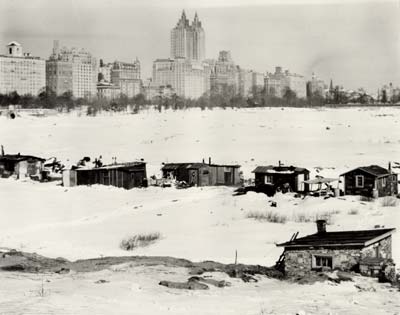
During the Great Depression, which began in 1929 and lasted approximately a decade, shantytowns appeared across the U.S. as unemployed people were evicted from their homes. As the Depression worsened in the 1930s, causing severe hardships for millions of Americans, many looked to the federal government for assistance. When the government failed to provide relief, President Herbert Hoover (1874-1964) was blamed for the intolerable economic and social conditions, and the shantytowns that cropped up across the nation, primarily on the outskirts of major cities, became known as Hoovervilles. The highly unpopular Hoover, a Republican, was defeated in the 1932 presidential election by Democrat Franklin Roosevelt (1882-1945), whose New Deal recovery programs eventually helped lift the U.S. out of the Depression. In the early 1940s, most remaining Hoovervilles were torn down.
Hoovervilles. History.com. https://www.history.com/topics/great-depression/hoovervilles. Accessed Sept. 10, 2020.

1932 Central Park, NYC. Hooverville.
https://www.reddit.com/r/HistoryPorn/comments/bpyf4i/1932_central_park_nyc_hooverville_2048_x1621/

“Camp Thomas Paine,” was home to dozens of World War I veterans; they lived in shacks in the West 70s near the Hudson River.
The squatters who lived in “Hardlucksville. Ephemeral New York. Oct. 8, 2008. ”https://ephemeralnewyork.wordpress.com/2008/10/08/the-hoovervilles-of-new-york-city/. Accessed Sept. 10, 2020.

Red Hook Hooverville off Columbia Street.
A Hooverville in Central Park. Ephemeral New York. Oct. 8, 2008. https://ephemeralnewyork.wordpress.com/2008/10/08/the-hoovervilles-of-new-york-city/. Accessed Spet. 10, 2020.

Hooverville Kids. Photographer. Britannica ImageQuest, Encyclopædia Britannica, 25 May 2016.
quest.eb.com/search/115_2729255/1/115_2729255/cite. Accessed 10 Sep 2020.

DEPRESSION: HOOVERVILLE. - A Hooverville shantytown, photographed c1930.. Fine Art. Britannica ImageQuest, Encyclopædia Britannica, 25 May 2016. quest.eb.com/search/140_1676173/1/140_1676173/cite. Accessed 10 Sep 2020.

HOOVERVILLE CARTOON, 1934. 'Prosperity must be here [Hooverville] - there's our first burglar.' Cartoon, 1934, by Otto Soglow.. Photograph. Britannica ImageQuest, Encyclopædia Britannica, 31 Aug 2017.
quest.eb.com/search/140_1790454/1/140_1790454/cite. Accessed 10 Sep 2020.

HOOVERVILLE CARTOON, 1934. - In Hooverville: 'Remember, Smithers, dinner at eight.' Cartoon, 1934, by Otto Soglow.. Fine Art. Britannica ImageQuest, Encyclopædia Britannica, 25 May 2016.
quest.eb.com/search/140_1648192/1/140_1648192/cite. Accessed 10 Sep 2020.

Central Park’s Great Lawn served as a Hooverville of sorts for out-of-work, homeless New York men.
A Hooverville in Central Park. Ephemeral New York. Oct. 8, 2008. https://ephemeralnewyork.wordpress.com/2008/10/08/the-hoovervilles-of-new-york-city/. Accessed Sept. 10, 2020.

“Hardlucksville” formed off 10th Street next to the East River. Five men resided there, selling firewood culled from the river: “The three of them saw up the wood into stove lengths. the two others peddle the product in the East Side streets, trundling it from door to door in baby carts reclaimed from the junk pile. Among the five they earn a half-dollar a day, and that supports them,” the Times reported.
The squatters who lived in “Hardlucksville”. Ephemeral New York. Oct.8, 2008. https://ephemeralnewyork.wordpress.com/2008/10/08/the-hoovervilles-of-new-york-city/. Accessed Sept.10, 2020.

Hooverville Man. Photographer. Britannica ImageQuest, Encyclopædia Britannica, 25 May 2016.
quest.eb.com/search/115_2739873/1/115_2739873/cite. Accessed 10 Sep 2020.